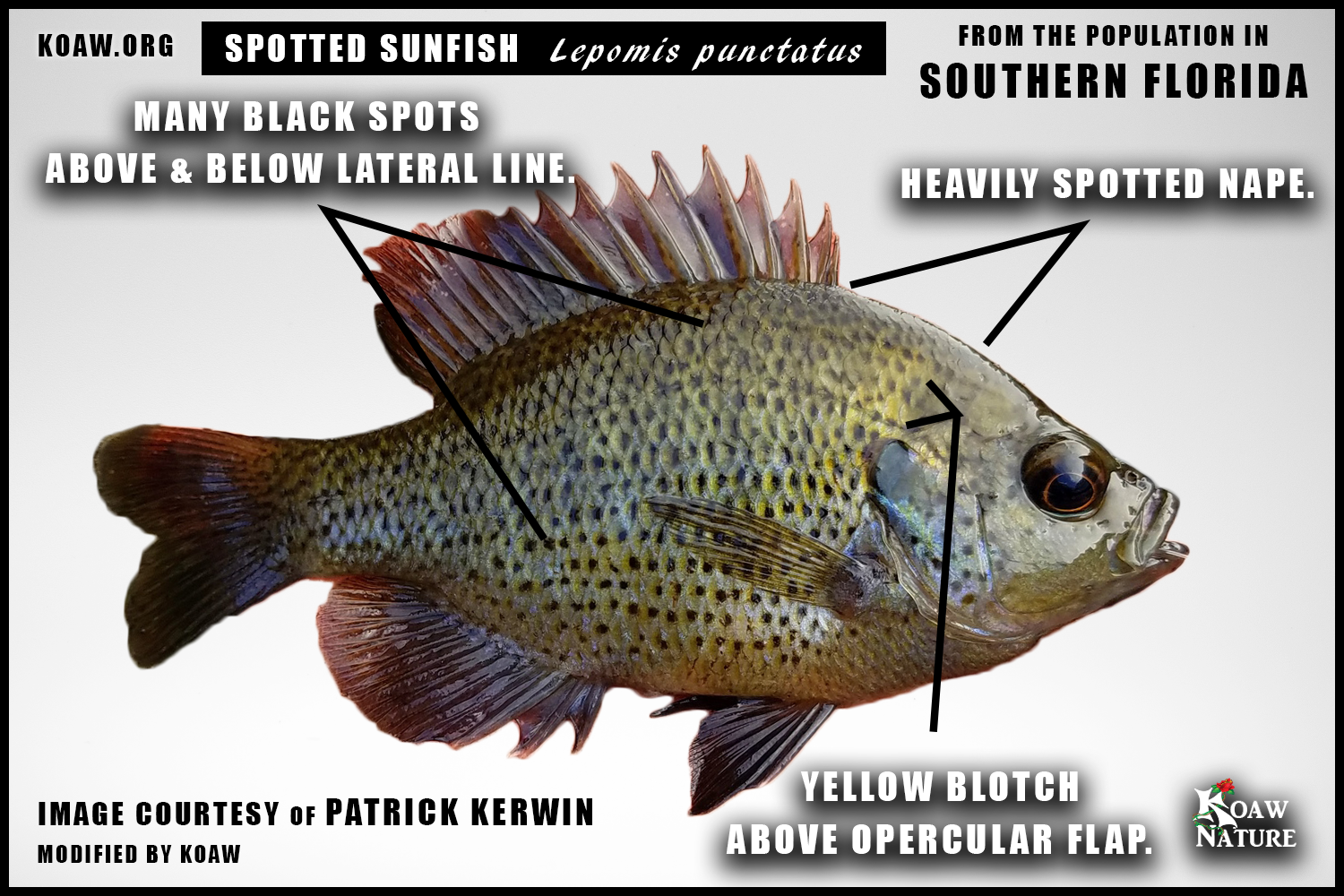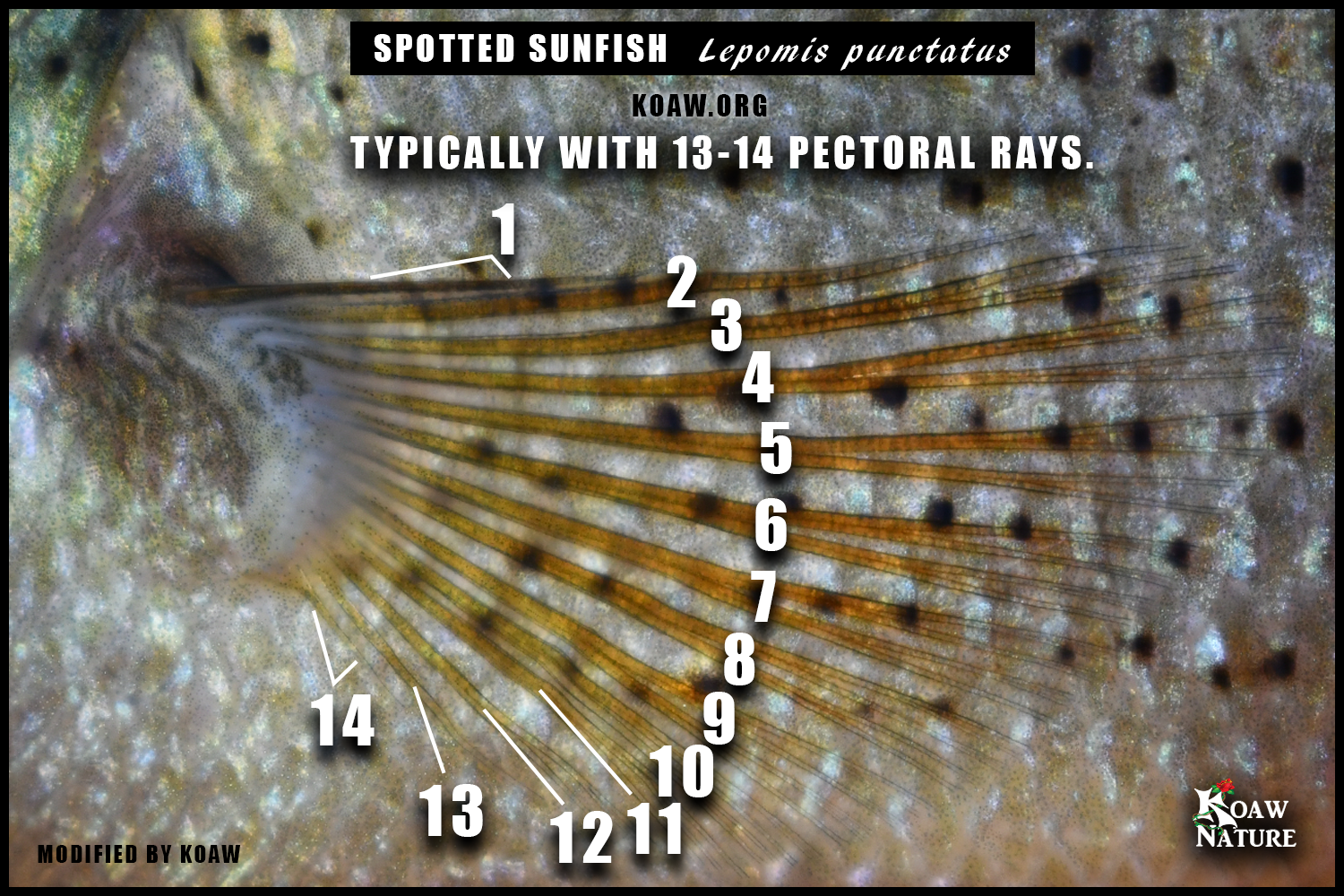By Koaw - November, 2020
GENERAL: The spotted sunfish (Lepomis punctatus – Valenciennes, 1831) appears very similar to the closely related redspotted sunfish (Lepomis miniatus); the two fishes were once listed as subspecies of the same species as L. p. punctatus and L. p. miniatus, respectively. [1] Substantial evidence provides morphometric, meristic and genetic comparisons to clearly distinguish the two very closely related species. [2] Introgressed specimens exist in the areas where the two species have populations with past (and current) overlapping ranges, of which, makes species-level identifications much trickier if not impractical. (See “LOCATION” below for discussion on overlapping ranges with L. miniatus; see “SIMILAR SPECIES” below to view the side-by-side comparison of these species.)
Key features to examine for an identification are the ventral iridescent ‘bowl’ in the eye, the discrete black spots that often form irregular horizontal rows along the body, the condition and number of spots on the head as well as the location of observation compared against the known range map.
BODY: Like with the other lepomids, the body is deep and compressed. The lateral line is complete with a lateral scale count usually at 38-44 (37-47). [2]
COLORATION: The spotted sunfish’s distinct feature is the black spotting that is almost always present along the body and head. These spots are often very discrete and small, forming irregular horizontal rows along the body and usually present both above and below the lateral line. Spots on the head extend dorsally to the nape. The very anterior portion of the head, including the snout, is usually lacking in spots. Light and dark orange colors may appear on the scales along the body in some populations though nothing as pronounced and red as the breeding males of the redspotted sunfish (L. miniatus).
The breast and belly are often a cream to yellow color. The lateral sides are typically a cream to light brown color that becomes slightly darker, sometimes olivaceous dorsally. Juveniles will have bars or broken bars and fewer spots than adults that are blurry, black or brown, and sometimes entirely absent. The bars on adults become far less apparent, if visible at all.
Click to enlarge.
Similar to the closely related redspotted sunfish, the spotted sunfish has an iridescent blue ‘bowl’ in the lower part of the eye that is also in the dorsal part of the eye, though less noticeably. This feature is unique to the spotted and redspotted sunfishes among all the lepomids. After examining many hundreds of specimen photos, I believe the spotted sunfish more often has a brighter, more evident blue marking in the eye compared to the redspotted sunfish.
The rays in the median fins often have an orangey color that is more pronounced distally, or away from the body. The median fins also tend to have a thin pink, cream, silver or white margin.[2] Young specimens typically have red/orange between the rays in the median fins, of which, may remain in adults in some populations. In adults, the membranes in the median fins are often clear, yellow, orange or even dusky. Breeding males will have pelvic fins that are entirely black.
SIZE: Typically not exceeding 20 cm (8 in) in total length, [3] where it is most common to encounter specimens around 8-9 cm in standard length. [2]
OPERCULAR FLAP: The opercular flap is short and entirely black with iridescent flecks. A light edging exists both dorsally and ventrally where these margins do not extend too far posteriorly. In breeding males, the dorsal (and sometimes ventral) margin will have faint pink, orange or yellowish-orange. The posterior edge of the opercular flap is often black or clear, sometimes with a very thin pale margin.
GILL RAKERS: The gill rakers along the 1st gill arch are long and thin. These are seen by lifting the gill cover and looking at the white portion above the red filaments on the gill arch closest to the gill cover.
The rakers on the spotted sunfish (L. punctatus) are typically longer than those of the redspotted sunfish (L. miniatus) where the longest raker typically is greater than 3.3 times longer than wide, whereas on the redspotted sunfish, the longest raker is typically only 2.5 – 3.5 times longer than wide. [2]
I made a video describing how to locate and find these rakers that is hosted on Koaw Nature’s Fishing Smarts YouTube channel.
MOUTH SIZE: The mouth is moderately-sized where the jaw usually extends in an alignment between the anterior edge of the eye and the anterior edge of the pupil.
More specifically, the maxilla’s posterior edge will align posteriorly to the anterior edge of the orbit and anteriorly to the anterior edge of the pupil.
The mouth is larger than that of a bluegill (Lepomis macrochirus) and smaller than that of a green sunfish (Lepomis cyanellus).
PECTORAL FIN: The pectoral fin is fairly short and roundly. If bent forward, the pectoral fin will usually not exceed the anterior edge of the pupil.
Typically there are 13-14 pectoral rays. [3] (See the photo in the image carousel above showing a pectoral ray count on a pectoral fin.)
HABITAT: The spotted sunfish does well in a variety of habitats from swamps to ponds and lakes as well as creeks and moderately-sized rivers. This fish is often associated with vegetation and over sandy or muddy benthic. [3]
CLICK TO ENLARGE - This distribution map is an illustrated approximation created by Koaw primarily pulling data and information from USGS-NAS, Research Grade observations from iNaturalist and Page & Burr’s Field Guide to Freshwater Fishes.
LOCATION: The spotted sunfish is almost entirely confined to the South Atlantic-Gulf Basin starting in the southeastern parts of North Carolina extending south and west into South Carolina, Georgia, Florida and regions in Alabama. [4] [3] [2]
CLICK TO ENLARGE - This distribution map is an illustrated approximation created by Koaw primarily pulling data and information from Warren 1991, USGS-NAS, Research Grade observations from iNaturalist and Page & Burr’s Field Guide to Freshwater Fishes.
CONTACT ZONE: The redspotted sunfish (L. miniatus) and spotted sunfish (L. punctatus) have overlapping ranges within the Florida panhandle from the Apalachicola Bay watershed westerly to Perdido Bay. Furthermore, introgressed specimens (or possibly semi-isolated, independently evolved populations) are encountered in Alabama in the Mobile River Basin and the northwestern parts of Georgia within the southern parts of the Tennessee River Basin. Within the approximated contact zone, specimens of the two species show traits with greater intermediacy than those specimens at the far westerly and easterly portions of their respective ranges. [2] Attempting to identify certain specimens to the species-level in the contact zone may not be possible.
Basically, with the possibilities of F1 hybridizations and ancient hybridizations that have led to introgressed populations as well as populations that may have independently evolved in semi-isolation, not to mention random introductions from anthropogenic means, it all becomes a rather confusing, yet beautiful, example of the complexities of evolution and the difficulties that arise when attempting to simply identify species.
FISHING: The spotted sunfish does not reach the sizes of the redear sunfish or the bluegill but will hit similar types of baits. A live worm on a hook, size 10 or larger, will work fine to capture mature specimens. If seeking juveniles, use much smaller hooks—or a net. I’ve seen fishers have success using soft plastics and small spinners (rooster-tail mimics).
For the specimens that I captured in North Carolina, I used a yellow spider-mimic fly with a size 10 hook that captured many nice, mature specimens. The water within the creek was extremely turbid (almost black) and moderately vegetated. The spotted sunfish must have been shoaling with bluegill in this location as I was catching both species with about the same frequency from the same pools.
SIMILAR SPECIES: I threw together this graphic showing a direct comparison of the redspotted sunfish (L. miniatus), the spotted sunfish (L. punctatus) as well as a specimen that was captured within the ‘contact zone’. The map within the graphic shows the exact location each specimen was caught.
While fishing in North Carolina for the spotted sunfish (Lepomis punctatus), I was catching a good deal of flier (Centrarchus macropterus) within the same water. It occurred to me that without a trained-eye the two species might be very difficult to distinguish. Below is a graphic illustrating the easiest features to examine.
REFERENCES:
W. N. Eschmeyer and J. D. Fong, "Species by Family/Subfamily in the Catalog of Fishes," 2016.
M. L. Warren, Jr., "Variation of the Spotted Sunfish, Lepomis punctatus Complex (Centrarehidae): Meristies, Morphometries, Pigmentation and Species Limits," Bull. Alabama Mus. Nat. Hist., vol. 12, pp. 1-47, 1991.
L. M. Page and B. M. Burr, Peterson Field Guide to Freshwater Fishes, Houghton Mifflin Harcourt Publishing Company, 2011, pp. 506-507.
Illinois Endangered Species Protection Board, "CHECKLIST OF ILLINOIS ENDANGERED AND THREATENED ANIMALS AND PLANTS," 2020.
USGS-NAS, "USGS-NAS Lepomis miniatus Range Map," [Online]. Available: https://nas.er.usgs.gov/queries/SpeciesAnimatedMap.aspx?SpeciesID=391. [Accessed October 2020].
iNaturalist, "Lepomis miniatus REDSPOTTED SUNFISH," 2020. [Online]. Available: https://www.inaturalist.org/taxa/104255-Lepomis-miniatus. [Accessed October 2020].
J. C. Wellemeyer, C. R. Harty and J. S. Perkin, "Occurrence of Lepomis miniatus (Redspotted Sunfish) in the Cumberland River Basin of Tennessee," Southeastern Naturalist Notes, vol. 15, no. 3, pp. N33-36, 2016.


